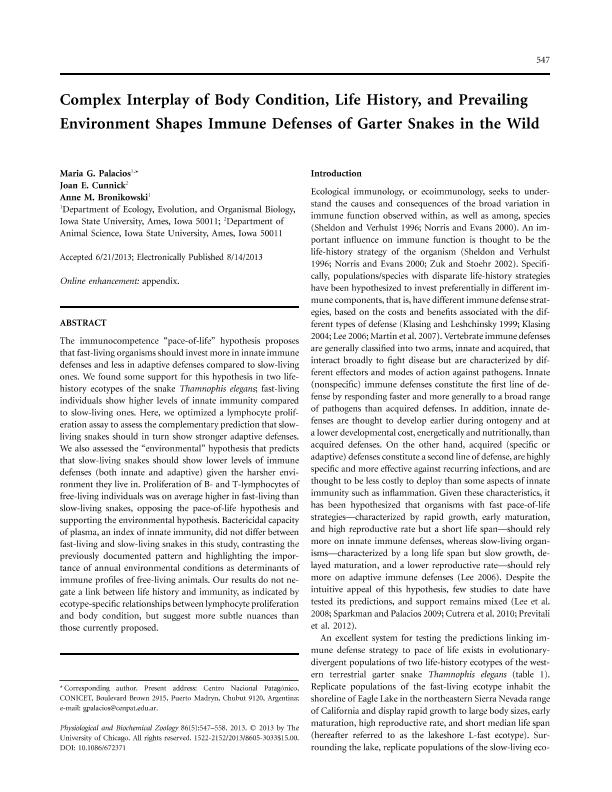Mostrar el registro sencillo del ítem
dc.contributor.author
Palacios, Maria Gabriela

dc.contributor.author
Cunnick, Joan E.
dc.contributor.author
Bronikowski, Anne M.
dc.date.available
2016-01-08T19:52:51Z
dc.date.issued
2013-09
dc.identifier.citation
Palacios, Maria Gabriela; Cunnick, Joan E.; Bronikowski, Anne M.; Complex interplay of body condition, life history, and prevailing environment shapes immune defenses of garter snakes in the wild; University of Chicago Press; Physiological and Biochemical Zoology; 86; 5; 9-2013; 547-558
dc.identifier.issn
1522-2152
dc.identifier.uri
http://hdl.handle.net/11336/3462
dc.description.abstract
The immunocompetence "pace-of-life" hypothesis proposes that fast-living organisms should invest more in innate immune defenses and less in adaptive defenses compared to slow-living ones. We found some support for this hypothesis in two lifehistory ecotypes of the snake Thamnophis elegans; fast-living individuals show higher levels of innate immunity compared to slow-living ones. Here, we optimized a lymphocyte proliferation assay to assess the complementary prediction that slowliving snakes should in turn show stronger adaptive defenses. We also assessed the "environmental" hypothesis that predicts that slow-living snakes should show lower levels of immune defenses (both innate and adaptive) given the harsher environment they live in. Proliferation of B- and T-lymphocytes of free-living individuals was on average higher in fast-living than slow-living snakes, opposing the pace-of-life hypothesis and supporting the environmental hypothesis. Bactericidal capacity of plasma, an index of innate immunity, did not differ between fast-living and slow-living snakes in this study, contrasting the previously documented pattern and highlighting the importance of annual environmental conditions as determinants of immune profiles of free-living animals. Our results do not negate a link between life history and immunity, as indicated by ecotype-specific relationships between lymphocyte proliferation and body condition, but suggest more subtle nuances than those currently proposed.
dc.format
application/pdf
dc.language.iso
eng
dc.publisher
University of Chicago Press

dc.rights
info:eu-repo/semantics/openAccess
dc.rights.uri
https://creativecommons.org/licenses/by-nc-sa/2.5/ar/
dc.subject
Adaptive Immunity
dc.subject
Bacterial Killing
dc.subject
Ecological Immunology
dc.subject
Reptile
dc.subject.classification
Zoología, Ornitología, Entomología, Etología

dc.subject.classification
Ciencias Biológicas

dc.subject.classification
CIENCIAS NATURALES Y EXACTAS

dc.title
Complex interplay of body condition, life history, and prevailing environment shapes immune defenses of garter snakes in the wild
dc.type
info:eu-repo/semantics/article
dc.type
info:ar-repo/semantics/artículo
dc.type
info:eu-repo/semantics/publishedVersion
dc.date.updated
2016-03-30 10:35:44.97925-03
dc.journal.volume
86
dc.journal.number
5
dc.journal.pagination
547-558
dc.journal.pais
Estados Unidos

dc.journal.ciudad
Chicago
dc.description.fil
Fil: Palacios, Maria Gabriela. Consejo Nacional de Investigaciones Científicas y Técnicas. Centro Nacional Patagónico; Argentina. Iowa State University. Department of Ecology, Evolution and Organismal Biology; Estados Unidos
dc.description.fil
Fil: Cunnick, Joan E.. Iowa State University. Department of Animal Science; Estados Unidos
dc.description.fil
Fil: Bronikowski, Anne M.. Iowa State University. Department of Ecology, Evolution and Organismal Biology; Estados Unidos
dc.journal.title
Physiological and Biochemical Zoology

dc.relation.alternativeid
info:eu-repo/semantics/altIdentifier/url/http://www.journals.uchicago.edu/doi/10.1086/672371
dc.relation.alternativeid
info:eu-repo/semantics/altIdentifier/doi/http://dx.doi.org/10.1086/672371
Archivos asociados
